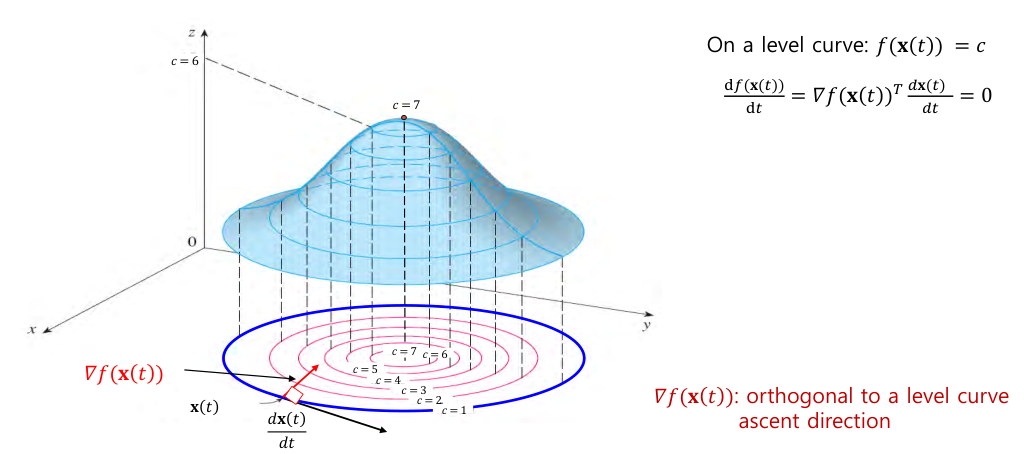Calculus Backgrounds
Matrix Derivatives
Types of Matrix Derivative
| Type | Scalar $y$ | Vector $\mathbf{y}$ $(m\times 1)$ | Matrix $\mathbf{Y}$ $(m\times n)$ |
|---|---|---|---|
| Scalar $x$ | $\frac{\partial y}{\partial x}$ | $\frac{\partial\mathbf{y}}{\partial x}$: $(m\times 1)$ | $\frac{\partial \mathbf{Y}}{\partial x}$: $(m\times n)$ |
| Vector $\mathbf{x}$ $(n\times 1)$ | $\frac{\partial y}{\partial \mathbf{x}}$: $(1\times n)$ | $\frac{\partial \mathbf{y}}{\partial \mathbf{x}}$: $(m\times n)$ | |
| Matrix $\mathbf{X}$ $(p\times q)$ | $\frac{\partial y}{\partial \mathbf{X}}$: $(p\times q)$ |
Pay attention to the dimensions!
Gradient and Hessian
- $\nabla f(x)$ = the gradient of $f$
- The transpose of the first derivatives of $f$.
- $\nabla^2 f(x)$ = the Hessian of $f$
- The matrix of second partial derivatives of $f$.
- The Hessian is a symmetric matrix.
Jacobian and Matrix Derivative
- Jacobian when $\mathbf{x} \in \mathbb{R}^n, \mathbf{y} \in \mathbb{R}^m$
- Matrix derivative when $\mathbf{X} \in \mathbb{R}^{p\times q}, \mathbf{Y} \in \mathbb{R}^{m \times n}, z \in \mathbb{R}$
Useful Matrix Derivative
For $A \in \mathbb{R}^{n \times n}$,
$\frac{\partial}{\partial x}(b^Tx) = \frac{\partial}{\partial x}(x^Tb) = b^T$
$\frac{\partial}{\partial x}(x^Tx) = \frac{\partial |x|^2}{\partial x} = 2x^T$
$\frac{\partial}{\partial x}(x^TAx) = x^T(A+A^T)$
- $2x^TA$ if $A$ is symmetric.
Chain Rule
Chain Rule
Theorem: Chain Rule
When the vector $x$ is dependent on another vector $t$, the chain rule for the univariate function $f:\mathbb{R}^n \rightarrow \mathbb{R}$ can be extended as follows:
\[\frac{df({\mathbf{x}(t)})}{dt} =\frac{\partial f}{\partial x} \frac{d \mathbf{x}}{d t} = \nabla f(\mathbf{x}(t))^T \frac{d \mathbf{x}}{d t}.\]
- If $z=f(\mathbf{y})$ and $y=g(\mathbf{x})$ where $\mathbf{x}\in \mathbb{R}^n, \mathbf{y}\in \mathbb{R}^m, z\in \mathbb{R}$, then
(gradients from all possible paths)
- or in vector notation
It is the basis of the back propagation technique in neural nets.
Chain Rule on Level Curve
- level curve : the set of $(x,y)$ such that $f(x,y)=c$.
- On level curve $f(\mathbf{x}(t)) = c$,
In other words, $\nabla f({\mathbf{x}(t)})$ is orthogonal to the level curve and points to the ascent direction in which $f$ increases.
Directional Derivatives
- $f$ is continuously differentiable and $p \in \mathbb{R}^n$, directional derivative of $f$ in the direction of $p$ is given by
Taylor Series Expansion
First order \(f(x+p) \approxeq f(x) + \nabla f(x)^Tp\)
Second order \(f(x+p) \approxeq f(x) + \nabla f(x)^Tp + \frac{1}{2}p^T\nabla ^2 f(x)p\)
In general search (or leaning) algorithms, the first order expansion is sufficient.
Through the Taylor series expansion, it can be shown simply that $\nabla f(x)$ is the ascent direction.
\[\begin{aligned} f(x+\lambda \nabla f(x)) &\approxeq f(x) + \lambda\nabla f(x)^T\nabla f(x) \\ &= f(x) + \lambda \| \nabla f(x) \|^2\\ &\ge f(x) \end{aligned}\]